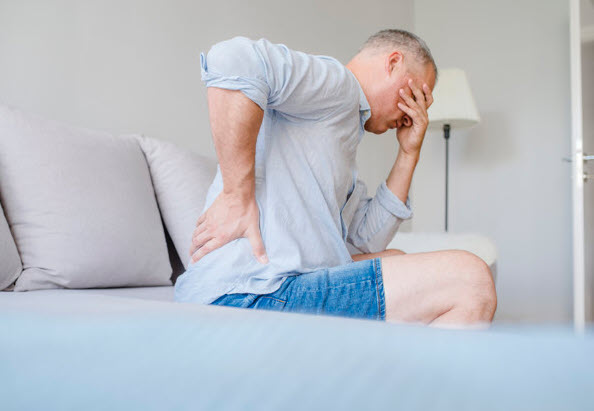Over 80% of Americans suffer from lower back pain at some point of their lives. This area of the back, called the lumbar spine, is full of muscles, bones, joints, ligaments and nerves working together to provide your body with strength and stability. It also offers mobility for motions like bending, twisting and walking. With so many complex parts, it’s no wonder that the lower back is at risk for injury and pain.
Causes of lower back pain
Injury to the discs, muscles, ligaments or joints in the back can cause acute lower back pain. This is typically a sudden and often severe type of pain, usually associated with the body’s response to injury by becoming inflamed. Inflammation in some parts of the body may not be a big deal, but it can cause severe pain in the lower back.
Chronic lower back pain is diagnosed when the condition lasts more than three months. Chronic pain is often linked to a disc, nerve or joint. Common causes are:
- Lumbar herniated disc
- Degenerative disc disease
- Spinal stenosis
- Osteoarthritis
- Sacroiliac joint dysfunction
- Facet joint dysfunction
- Compression fracture
- Trauma
- Deformity such as scoliosis or kyphosis
It’s not always possible to pinpoint the exact cause of lower back pain. Since many tissues can generate the pain, doctors sometimes find it difficult to identify. This is commonly referred to as nonspecific low back pain.
A variety of things can also contribute to lower back pain, such as improper lifting, incorrect ergonomics, prolonged sitting, repetitive torsal motions, vibratory forces like jack hammer operation or truck driving, incomplete rehabilitation of previous injuries, poor posture, physical inactivity, poor nutrition, and smoking.
Treatments for lower back pain
Home remedies are sometimes effective and are the first line of defense for lower back pain. Some methods to try are:
- Rest – avoid strenuous physical activities, although not more than a few days to minimize the risk of slowing the healing process.
- Behavior change – avoid behaviors that cause pain, such as long periods of sitting or extended periods of standing. Minimize positions or activities that worsen your pain, giving your back a greater ability to heal.
- Medications – use over-the-counter pain medications like ibuprofen, naproxen, or acetaminophen as directed.
- Ice and heat therapy – if your lower back is painful from inflammation, use ice packs to reduce swelling. Alternate ice therapy with heat, such as warm baths or heating pads, which will improve circulation and relax muscles. Try applying heat before activities and ice afterwards.
- Exercise – perform exercises that benefit the spine. Strengthening exercises that focus on the core muscles (abdomen, hip, gluteus) can relieve lower back pain. Stretching exercises for the muscles that support the upper body’s weight, such as those in the lower back, hips, buttocks and legs, will make you more flexible and reduce your risk for back injury and pain. Low-impact aerobic exercise promotes circulation and benefits your entire body.
If home treatment is not sufficient in relieving your lower back pain, seek medical care from a professional like NYC Spine Surgeon Dr. Fischer at NYU Langone Medical Center in New York City. Your condition will be evaluated to determine the source of your pain and a plan for alleviating it will be developed. In addition to physical therapy as needed, medical treatments may be prescribed. This might include narcotic pain medications, muscle relaxants, epidural steroid injections, or back braces.
Other options might be considered for lower back pain to complement medical treatment. This can include manual manipulation by a chiropractor, acupuncture, massage therapy, or meditation. Severe lower back pain can require surgery if up to 12 weeks of non-surgical methods are unsuccessful. Surgery is nearly always the last treatment recommended, if all other methods still leave you with nagging lower back pain. If your lower back is giving you fits and home remedies aren’t doing the trick, schedule an appointment with Dr. Fischer to get relief and restore your normal life.

